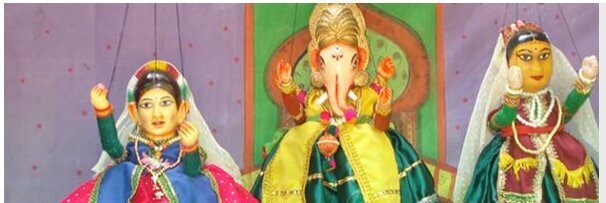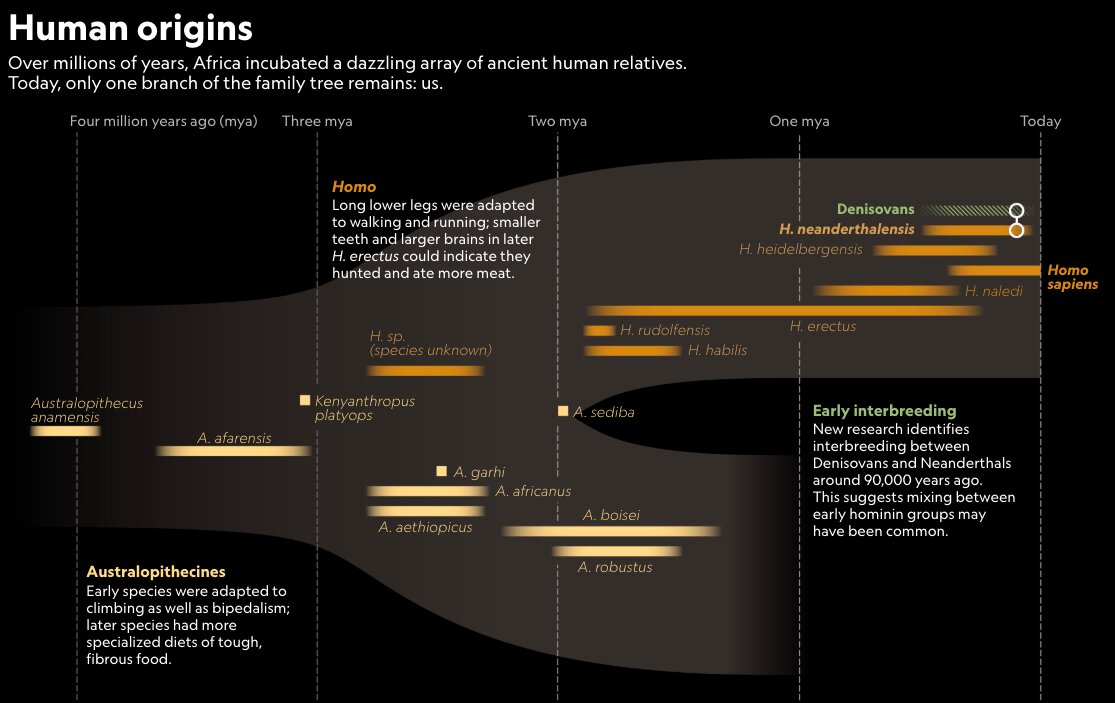International Relations
Iran Sanctions: India Lines Up Alternative Sources
India and seven other countries will not be able to import cheaper Iranian oil without attracting US sanctions after May 1st, 2019 when the American administration will end all the waivers on Iranian oil imports.
Why USA is putting sanction on Iran?
- In 2015, P5+1(America, Russia ,UK, China ,France & Germany) countries reached a deal with Iran on lifting of economic sanction on Iran , on condition that Tehran would give up a bulk of its nuclear programme and would also submit itself to extremely invasive inspections from time to time.
- But US, under Donald Trump, contends that the nuclear agreement did nothing to deter Iran from eventually obtaining nuclear weapons, and hence wants the restrictions imposed by the accord to be permanent.
- US also wants Iran to abandon its ballistic missile development and to stop supporting militant groups in Lebanon, Syria, Yemen and elsewhere that United States regards as terrorist organizations.
- Impact: Any country cannot import Iranian oil without inviting sanctions from America. Sanctions are also applicable on banking transactions from Iran.
Why Iranian oil is important to India?
- India is the world’s third largest oil importer, and a large share of that comes from Iran (23.5 million tonnes in 2018-9). Not only is Iran India’s third largest supplier (vs just 3% of oil imports from the US), there are other associated benefits like – 60-day credit, free insurance, free on board (FOB) basis and a barter-of-goods arrangement.
- Additionally, there are a number of strategic reasons why India wants to continue buying Iranian oil :
- Shia Iran is seen by India as an ally against the predominantly Sunni Pakistan. Pakistan’s traditionally close relations with Saudi Arabia made Iran a possible ally. Iran’s position on Pakistan’s flank is also attractive, as is the perception of common Indian-Iranian interest in countering Pakistan’s influence in Afghanistan.
- India also sees Iran as a conduit to Central Asia, a region that India considers strategically vital.
- India has also invested in Chabahar port in Iran and highways that provide an alternative route to both Afghanistan and Central Asia, bypassing Pakistan, thereby making Iran important for long term interests of India.
Alternatives to Iranian Oil
- India does have alternate options – Saudi Arabia, the UAE, and even the United States are potential suppliers that could replace Iran as an oil source. Apart from it , discovery of huge oil field in Guyana, offers a alternative source to India.
- Guyana Oil Import: India is looking to secure an interest in Guyana’s oil fields that are being hailed as one of the world’s largest oil fields in recent times.
- ExxonMobil, one of the world’s largest publicly-traded energy firms, announced an estimated reserve of more than five billion oil-equivalent barrels in the offshore Stabroek block in the South American country, Guyana.
- The fact that Guyana borders Venezuela, which has one of the world’s biggest oil reserves, has further raised the expectations.
- India is looking for farm-in opportunities in Guyana.
- Under a “farm-in" contract, an energy firm acquires a stake in a discovered or producing field, the lease of which is owned by another firm.
- Guyana Oil Import: India is looking to secure an interest in Guyana’s oil fields that are being hailed as one of the world’s largest oil fields in recent times.
Guyana
- Guyana is a country that is located in the northeastern corner of South America.
- It is bordered by the Atlantic Ocean to the north, by Suriname(along the Courantyne River) to the east, by Brazil to the south and southwest, and by Venezuela to the west.
- India has invested more in its relationship with Saudi Arabia and other anti-Iranian Gulf monarchies. Such improvement in relationships will put pressure on India to moderate its support for Iran.
- India has also grown increasingly close to Israel, a country that is the source of vital military equipment for India.
- Iran’s positioning on a number of issues that matter to India is no longer very reassuring to New Delhi. For instance, Iran appears to be more closely aligned to Pakistan on Afghanistan than before, as evidenced by Pakistan Prime Minister’s recent trip to Iran.
- United States itself is an increasingly vital partner for India. Joining China in defying American sanctions on the Iran issue may not be particularly wise given the broader interests that Washington and New Delhi share.
Biodiversity & Environment
World Heritage Glaciers
Glaciers are set to disappear completely from almost half of World Heritage Sites if business-as-usual emissions continue, according to the first-ever global study of World Heritage glaciers. The study, ‘Disappearing World Heritage glaciers as a keystone of nature conservation in a changing climate has been co-authored by scientists from the International Union for Conservation of Nature (IUCN).
- The authors of the study also developed the first ever inventory of glaciers on the UNESCO World Heritage list, documenting about 19,000 glaciers present in 46 out of the 247 natural World Heritage sites.
- The sites are home to some of the world’s most iconic glaciers, such as the Grosser Aletschgletscher in the Swiss Alps, Khumbu Glacier in the Himalayas or Greenland’s Jakobshavn Isbrae.
- Climate change is the fastest growing threat to natural World Heritage sites, according to the IUCN World Heritage Outlook 2 Report, with the number of sites threatened by climate change doubling between 2014 and 2017.
- Natural World Heritage sites are recognised as the planet’s most important protected areas, providing life-supporting benefits to millions of people worldwide.
Key Findings
- The authors predict glacier extinction by 2100 under a high CO2 emission scenario in 21 of the 46 natural World Heritage sites where glaciers are currently found.
- Even under a low emission scenario, 8 of the 46 World Heritage sites will be ice-free by 2100.
- The study also expects that 33% to 60% of the total ice volume present in 2017 will be lost by 2100, depending on the emission scenario.
- Several iconic landscapes found in World Heritage sites will be impacted by rising temperatures.
- Los Glaciares National Park in Argentina contains some of the largest glaciers on the Earth and is threatened by very large ice loss – about 60% of the current volume – by 2100.
- In Europe, the disappearance of small glaciers is projected in the Pyrenees -- Mont Perdu World Heritage site before 2040.
- Te Wahipounamu -- South West New Zealand, which contains three quarters of New Zealand's glaciers, is projected to lose 25% to 80% of the current ice volume over the course of this century.
- Impact
- Loss of glaciers will have major consequences for the availability of water resources, sea level rise and weather patterns.
- This unprecedented decline can also jeopardise the listing of the sites in question on the World Heritage list.
- Suggestions
- Significant cuts need to be made in greenhouse gas emissions.
- This study further emphasises the need for individual and collective actions to achieve the mitigation and adaptation aspirations of the Paris Agreement on climate change.
World Heritage List
- The United Nations Educational, Scientific and Cultural Organization (UNESCO) seeks to encourage the identification, protection and preservation of cultural and natural heritage around the world considered to be of outstanding value to humanity. It has World Heritage List for the same.
- This is embodied in an international treaty called the Convention concerning the Protection of the World Cultural and Natural Heritage, adopted by UNESCO in 1972.
International Union for Conservation of Nature (IUCN)
- IUCN is a membership Union uniquely composed of both government and civil society organisations.
- Created in 1948, IUCN has evolved into the world’s largest and most diverse environmental network.
- It is headquartered in Switzerland.
- The IUCN Red List of Threatened Species, is the world's most comprehensive inventory of the global conservation status of plant and animal species.
- The IUCN World Heritage Outlook provides conservation outlook assessments for all natural World Heritage sites.
Internal Security
High Security Number Plates
Why in New?
The issuing of certificate of registration (RC) for all classes of motor vehicles has been blocked from 2nd May 2019 in the country for not integrating High Security Registration Plates (HSRP) with the 'Vahan' database.
Why it is Being Done?
The Ministry of Road Transport & Highways (MoRTH) has taken this step to curb vehicle theft and enable easier tracking of lost and stolen vehicles. The new amendment of the Central Motor Vehicles Rules, 1989 has made it mandatory for all vehicles sold on or after April 1, 2019 to be pre-fitted with High Security Registration Plates (HSRP).
High security Registration Plates
The high security number plates are made of aluminum and come with reflective tapes. The plates are tamper-proof equipped with a chromium-based and self-destructive hologram, which is hot stamped on the plate. In addition, a sticker on the plate carries all the essential details including the vehicle's engine and chassis number and laser-branding of a 10-digit permanent identification number.
Advantage of High Security Number Plates
With the use of the high security plate throughout the country, the details about the car, engine and the chassis number will be stored in the national database. Through this centralized record of bikes and cars, it would be easy to identify any vehicles.
Indian Heritage & Culture
Pinguli Chitrakatha Art
- "Chitra" means picture and "Katha" means story and the exponent called Chitrakathi is the person who narrates the story with the aid of some visual support. It is practised in Pinguli, a small village near Kudal, in the district of Sindhudurg in Maharashtra, dating back to the 17th century.
- It is tribal art, practised by Thakar tribe of Maharashtra. Thakar community is considered to be a scheduled tribe with a population of 2000 and the same is subdivided into thirty-six sub-castes or group-castes (Sub-caste is also known as Jamat).
- Broadly speaking, Chitra Katha is identified in four forms:
1. Leather Shadow Puppets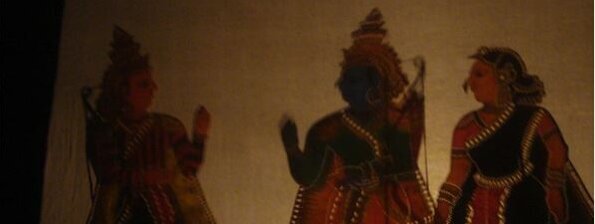
These two-dimensional profiles of mythological people cast haunting, colourful and vibrant shadows on a screen of thin cloth. The performance is usually at night, back-lit by huge oil lamp, with the complement of reading instrument and singing. The puppets are made out of leather beaten paper thin and painted by Natural dyes cut and perforated.
2. Stringed Wooden Puppets (Kalsutri)
The string puppets about 1.5ft in size are carved of wood and colourfully clothed. Their faces are painted representing mythological heroes, queens, demons & humble servants. The nimble fingers of Artist along with the singers and drum players create a fantastic three-dimensional drama full of spirit.
3. Picture Stories (known as Chitrakathi)
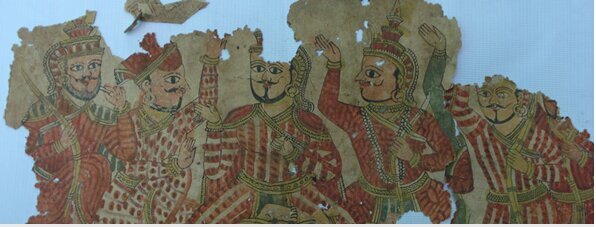
A series of paintings describing traditional stories are claimed to be with the Thakar community for over 300 years. The stories belong to Ramayana, Mahabharata and Nandi Puran. By showing painting and singing alongside the artist builds vivid narratives. The paintings are usually 12″x18″ and the paints are from natural sources. The sutradhar (narrator) unfolds the tale in the form of songs supported by the music of the vina, the taal and the huduk.
4. Bullock Art Show
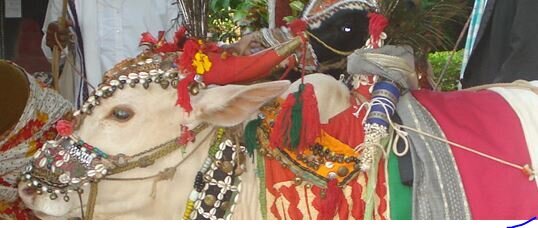
These secret bull along with his master, the drum beater, roam around from house to house and village to village, blessing people and receiving alms. The bull is draped and ornamented with interpret embroidery bells and peacock feathers
- Many individuals from this tribe were craftsmen of one type of the other. The main occupation was to move from village to village and entertain people. Many of them used to work as spies of rulers and especially during the reign of Maratha Kings, they were very active. Under the pretext of narrating episodes from Ramayana and the Mahabharata through pictures, puppets and other visual aids they used to establish closer contact with the people, to extract political secrets and to furnish such information to the village heads.
Important Facts For Prelims
Important Facts For Prelims (3rd May 2019)
Panchaloha Images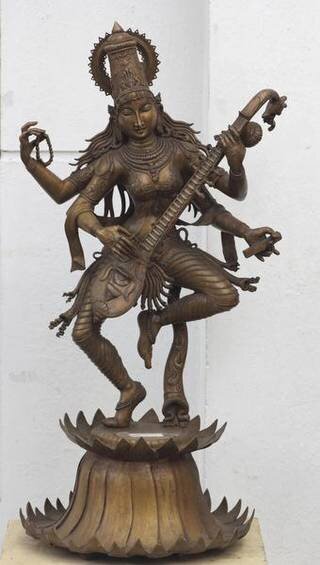
- Panchaloha is traditionally described as an alloy of gold (Au), silver (Ag), copper (Cu), zinc (Zn) and iron (Fe) as the major constituents. Also, in some cases tin (Sn) or lead (Pb) is used instead of zinc.
- It is an ancient craft, exclusive to South India, which thrives due to its beauty and the sentiment of tradition associated with it.
- For instance, in the given picture, Nataraja is a hand made panchaloha sculpture cast by the artists of South India using the lost wax process, a skill passed on for generations since the Chola period.
- Often in the news in the context of smuggling, the gold-like metal exudes divinity.
- The composition is laid down in the Shilpa shastras, a collection of ancient texts that describe arts, crafts, and their design rules, principles and standards.
- Late S. Devasenapathy is conferred a national award in 1984 for this art form. His family dates back to the period of Raja Raja Chola, who deployed their services in the construction of the Big Temple (Sri Brihadeeswara Temple ) in Thanjavur.
- Swamimalai of Thanjavur district, T.N is the hub of bronze and panchaloha products.
- The government of India has given patent to this art form of Swamimalai.
Gujarat Salt for De-icing
- For the past three years, the salt export from Gujarat has significantly shot up with the major chunk being used in de-icing the roads in the countries reeling under heavy snowfall.
- Generally, the salt export for de-icing starts from the month of September. During this period, the salt export touches around 7-8 lakh tonnes per month from the average four lakh tonnes.
- De-icing is the process of removing snow or ice from the surface of the roads, mostly done by using sodium chloride or other chemicals.
- This is done to prevent fatal accidents caused by slippery roads in sub-zero conditions.
- Salt or sodium chloride is preferred as it is comparatively inexpensive.
- Gujarat accounts for 90% of the salt exported from India.
- The salt made in Gujarat is routed through China to the European and American countries and Russia due to lesser logistics cost.
- China also exports its inferior quality salt for de-icing in Polar countries.
Denisovan
- Scientists have uncovered the most complete remains yet from the mysterious ancient-hominin group known as the Denisovans.
- The jawbone, discovered high up on the Tibetan Plateau and dated to more than 160,000 years ago, is also the first Denisovan specimen found outside the Siberian cave in which the hominin was uncovered a decade ago — confirming suspicions that Denisovans were more widespread than the fossil record currently suggests.
- Hominins are part of the family, or larger group of primates, called hominids. Hominids include orangutans, gorillas, chimpanzees, and human beings. All hominins are hominids, but very few hominids are hominins.
Draft Rules for Poultry Farming
Recently draft rules have been laid under Prevention of Cruelty to Animals (Egg-laying Hens) Rules, 2019, after High court issued a directive regarding cruelty in poultry Farms.
Draft rules for better poultry farming practices
- Poultry farms in the country have to have a minimum space of not less than 550 sq cm.
- They cannot put more than 6-8 birds in a cage.
- Antibiotics has to be used only for therapeutic purposes and that, too, under supervision by a veterinarian.
- The policy also bars feeding hens with the remains of dead chicks, thereby preventing diseases to the hens and also benefiting healthy commercial egg production in the country.

